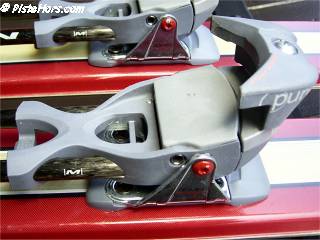> would the manufacturers give me a technical spec on the forces touring bindings can stand up to!
I don’t know but I’ve found them to be a bit cagey about giving out too much technical information. You might have more luck.
Last weekend we took a pair of Silvretta Freeride 800 skis for a test drive. These skis were equipped with a pair of Pure Freeride bindings. The FR800 is the top of Silvretta’s 2007/8 line-up. It is a mid-fat freerando ski built using a wood core and honeycomb construction. The graphics are very pleasant, a pair of burgundy stripes with a translucent top sheet. The FR800 has identical dimensions to the Atomic Sweet Daddy, 118-80-106mm. This gives plenty of float underfoot for powder. The ski remains light - in 175cm a pair weighs around 2800 grammes, 200 grammes less than the equivalent Sweet Daddy but the FR800 gains 3cm in length.
Okay this is not light but size does matter. We climbed about 3000 meters over 2 days (with a bad cold) and didn’t find the weight of the FR800/Freeride combination to be a handicap. The ski is not overly shaped, just enough to make turns easier but still stiff and straight enough to provide grip on icy slopes both when climbing and descending. The ski requires a 90mm ski crampon.
The first day was a tour to the Selle du Puy Gris in the Maurienne valley. It had snowed the day before but slopes had already settled under the warm spring skies. This gave us the chance to try the FR800 on firn snow and heavy powder. The ski preferred medium radius turns and gave the feeling of stability at speed, possibly due to its anti-vibration inserts and carbon fibre reinforcements. It also floated well on the melted glop we encountered at the end of our tour.
The weather changed overnight. Strong winds and around 10cm of fresh snow. The fresh powder would give us some different conditions for our test although the avalanches going off around us were somewhat disconcerting. The wind had worked the snow giving it a slabby texture. Not the champagne powder of ski movies. It was important to be well balanced on the FR800 fore and aft and not ski too far back when the wide tails would tend to snag on the hard base below the shallow coating of fresh snow. As with the day before the skis preferred to be given their head and not forced into tight “randonnee” turns. The real surprise was down in the forest where they proved very agile in the brushwood slalom.
The skis were equipped with the Silvretta Pure Freeride ski touring binding. This is a strengthened version of the original Pure binding. Now it should be noted that the first version of the Pure had a number of problems with the toe piece. On the 2007/8 Pure Freeride (and on the other models) this part has been redesigned. The sliding plate that help boot release is gone, replaced by a slippery piece of solid plastic, the “soap bar”. The pivot has been modified and the toe casting strengthened. The toe piece is a solid unit so it is hard to see why it should have failed in the original model. Silvretta’s French spokesman told us it was a quality control issue. The redesign complies with new DIN requirements for 2008/9 and can be used with both touring and alpine ski boots.

The bindings go up to DIN 12 release. Useful if you are touring with a heavy pack. Release is vertical at the heel and horizontal at the toe. This is achieved by having the heel unit slide back and forth on the link rails. It is a pretty neat piece of design that works. The only thing that was slightly disconcerting was the boot moving backwards slightly when climbing a steep slope; still we had only set the horizontal release to 6.
The Pure Freeride weighs around 1850 grammes for the pair including ski brakes. The step-in and out convenience was great. Due to the poor snow year in the Alps we had to remove skis to cross streams and bare ground and gained time on our Dynafit equipped colleagues. The ski brakes worked fine although we wonder if they would stop a ski on an icy 40 degree slope. Probably not but they wouldn’t drag you under in an avalanche. The heel unit has a riser that offers three climbing positions for steeper slopes. We found the binding to be solid and very easy to use. It would probably be good for a mixed resort/touring setup. Climbing was aided by the pivot point being set 30mm back from the toe, this particularly helped conversion turns on steep ground.
The FR800 will retail at 400 euros with the Pure Freeride costing 359 euros although many stores will offer the combo as a package at a discount. Of course the FR800 would work with any binding and would be quite light with Dynafit TLT Speeds. Specially shaped skins are available to fit.
> would the manufacturers give me a technical spec on the forces touring bindings can stand up to!
I don’t know but I’ve found them to be a bit cagey about giving out too much technical information. You might have more luck.